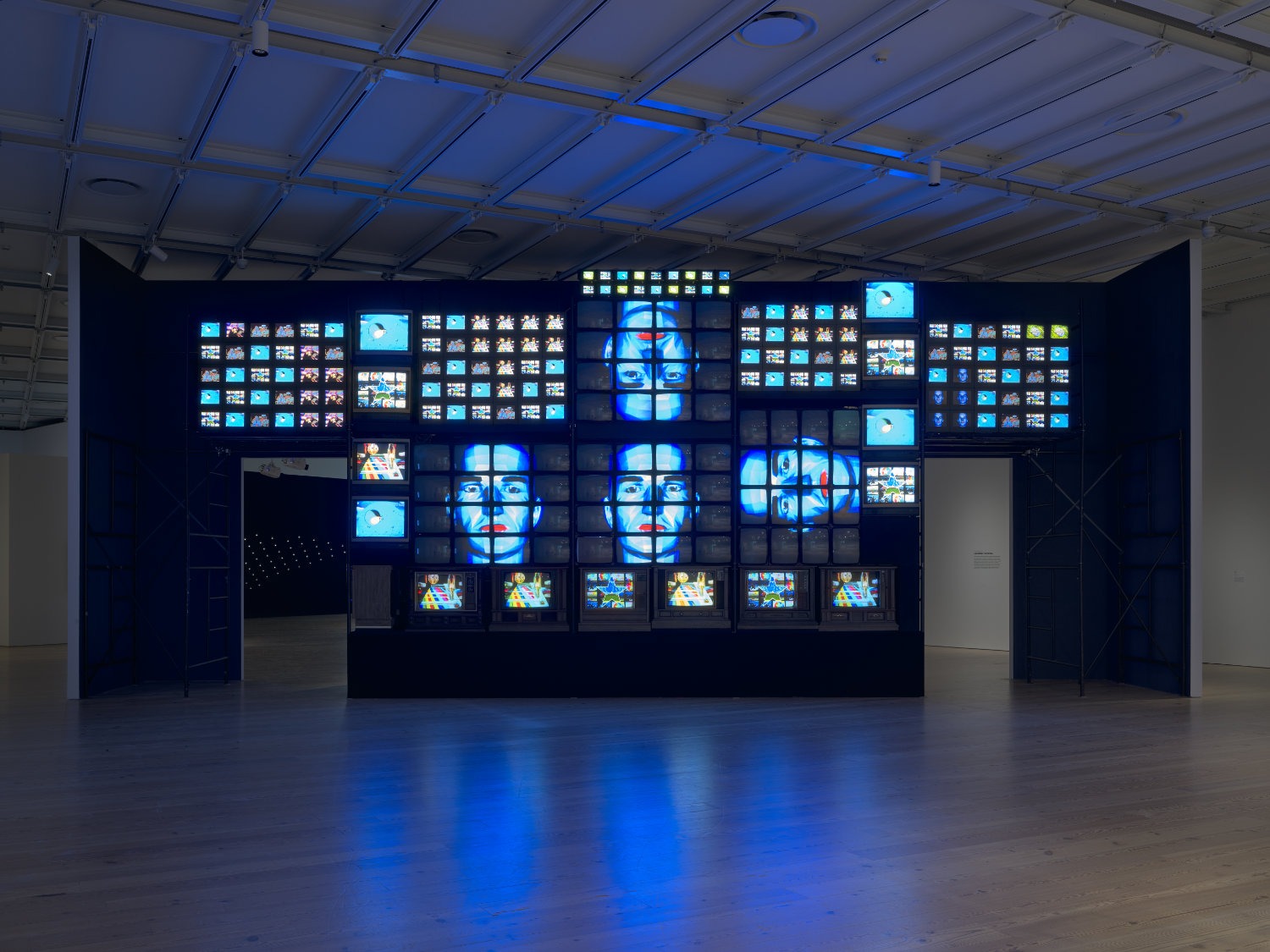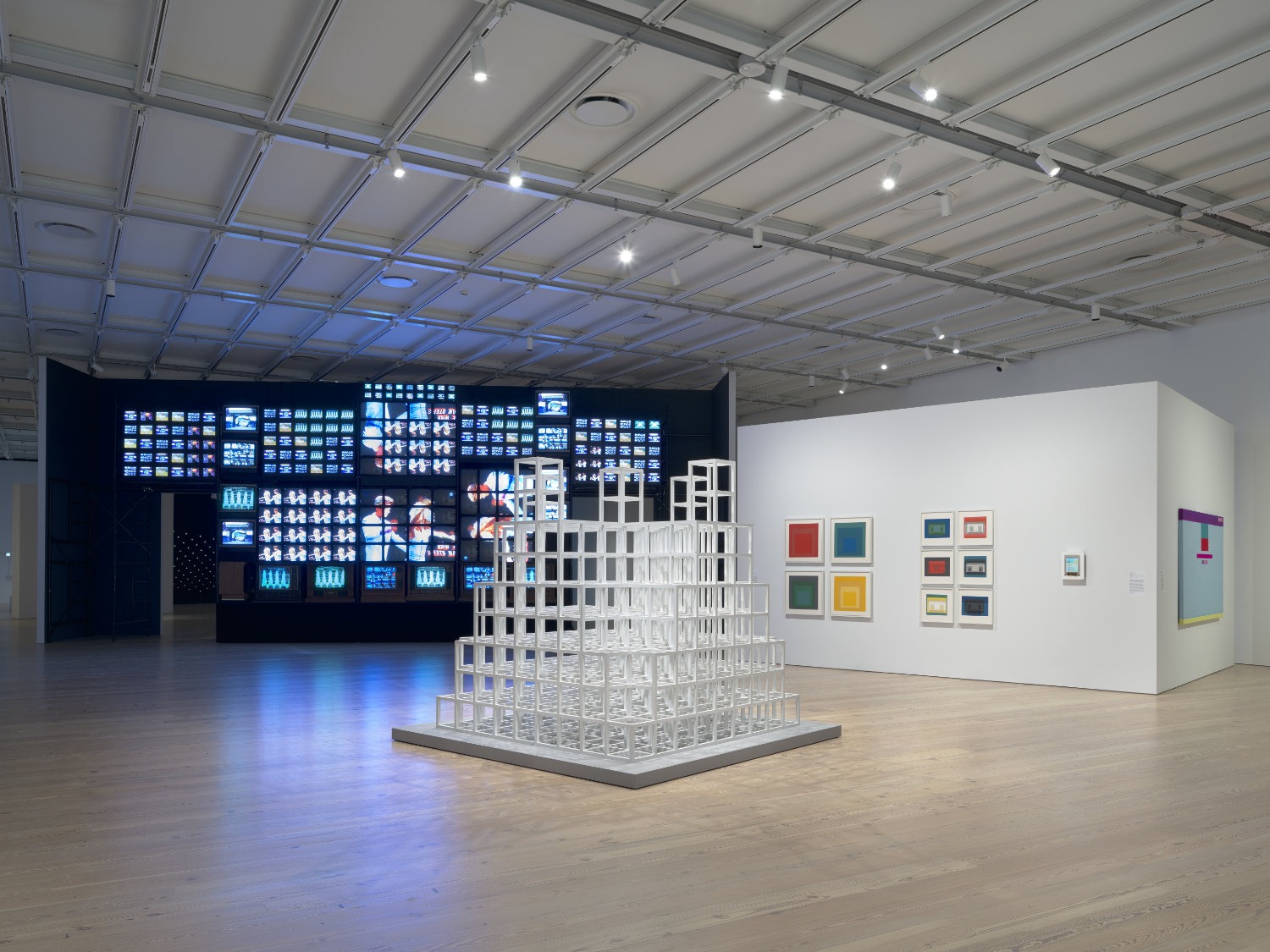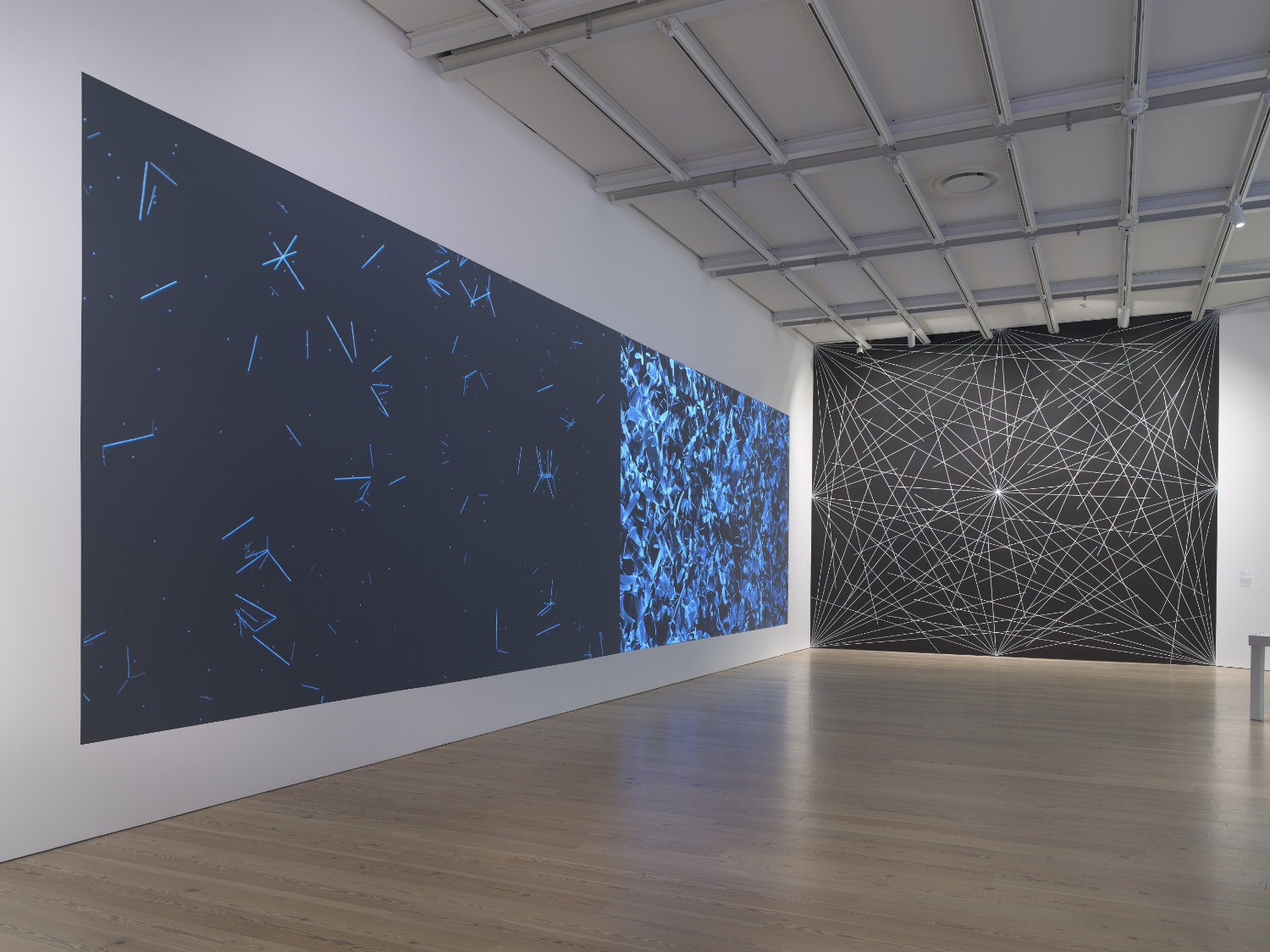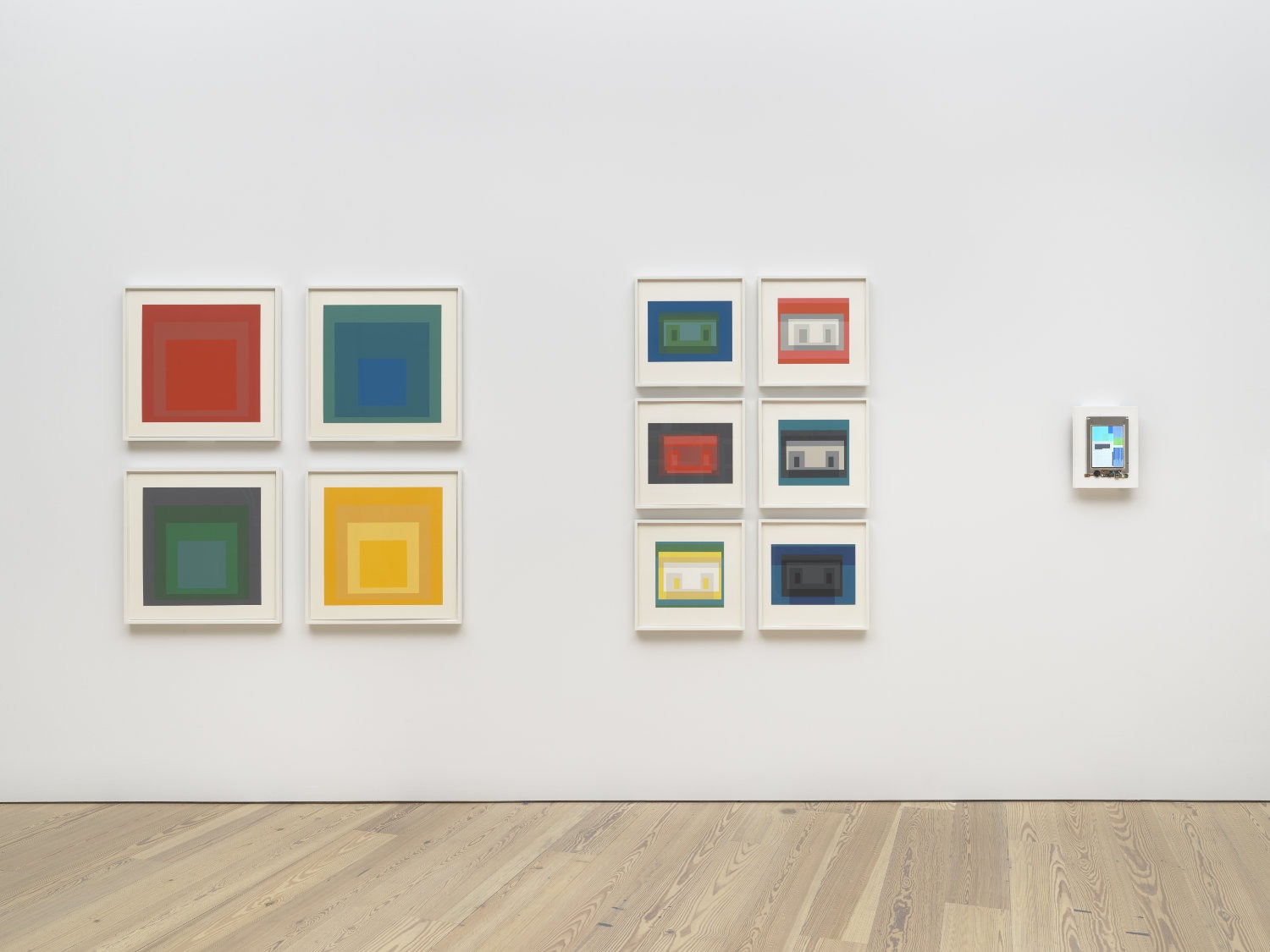Programmed
Rules, Codes, and Choreographies in Art, 1965–2018
28 Sep 2018 - 14 Apr 2019

Nam June Paik (1932-2006), Fin de Siècle II, 1989 (partially restored, 2018) (installation view, Programmed: Rules, Codes, and Choreographies in Art, 1965-2018, Whitney Museum of American Art, New York, September 28, 2018-April 14, 2019). Seven-channel video installation, 207 televisions, sound, 168 × 480 × 60 in. (426.7 × 1219.2 × 152.4 cm). Whitney Museum of American Art, New York; gift of Laila and Thurston Twigg-Smith 93.139. © Nam June Paik Estate. Photograph by Ron Amstutz

Installation view of Programmed: Rules, Codes, and Choreographies in Art, 1965-2018 (Whitney Museum of American Art, New York, September 28, 2018-April 14, 2019). From left to right: Nam June Paik, Fin de Siècle II, 1989 (partially restored, 2018); Sol LeWitt, Five Towers, 1986; Josef Albers, Homage to the Square V, 1967; Josef Albers, Homage to the Square IX, 1967; Josef Albers, Homage to the Square XII, 1967; Josef Albers, Homage to the Square X, 1967; Josef Albers, Variant V, 1966; Josef Albers, Variant VI, 1966; Josef Albers, Variant X, 1966; Josef Albers, Variant IV, 1966; Josef Albers, Variant II, 1966; Josef Albers, Variant VII, 1966; John F. Simon Jr., Color Panel v1.0, 1999; Rafaël Rozendaal, Abstract Browsing 17 03 05 (Google), 2017. Photograph by Ron Amstutz

Sol LeWitt (1928-2007), Wall Drawing #289, 1976. Wax crayon, graphite pencil, and paint on four walls, dimensions variable. Whitney Museum of American Art, New York; purchase with funds from the Gilman Foundation, Inc. 78.1.1-4. © 2018 Sol LeWitt/Artists Rights Society (ARS), New York

Installation view of Programmed: Rules, Codes, and Choreographies in Art, 1965-2018 (Whitney Museum of American Art, New York, September 28, 2018-April 14, 2019). From left to right: Casey Reas, {Software} Structure #003 A, 2004 and 2016; Casey Reas, {Software} Structure #003 B, 2004 and 2016; Sol LeWitt, 4th Wall: 24 lines from the center, 12 lines from the midpoint of each of the sides, 12 lines from each corner, 1976. Photograph by Ron Amstutz

Casey Reas (b.1972), {Software} Structures #003 B, August 2004/2016. Java, Adobe Flash Player. Commissioned by the Whitney Museum of American Art for its artport website AP.2004.5

W. Bradford Paley (b.1958), Code Profiles, September 2002. Java applet. Commissioned by the Whitney Museum of American Art for its artport website AP.2002.11

Installation view of Programmed: Rules, Codes, and Choreographies in Art, 1965-2018 (Whitney Museum of American Art, New York, September 28, 2018-April 14, 2019). From left to right, top to bottom: Nam June Paik, Fin de Siècle II, 1989 (partially restored, 2018); Josef Albers, Homage to the Square V, 1967; Josef Albers, Homage to the Square IX, 1967; Josef Albers, Homage to the Square XII, 1967; Josef Albers, Homage to the Square X, 1967; Josef Albers, Variant V, 1966; Josef Albers, Variant VI, 1966; Josef Albers, Variant X, 1966; Josef Albers, Variant IV, 1966; Josef Albers, Variant II, 1966; Josef Albers, Variant VII, 1966; John F. Simon Jr., Color Panel v1.0, 1999; Rafaël Rozendaal, Abstract Browsing 17 03 05 (Google), 2017. Photograph by Ron Amstutz

Installation view of Programmed: Rules, Codes, and Choreographies in Art, 1965-2018 (Whitney Museum of American Art, New York, September 28, 2018-April 14, 2019). From left to right, top to bottom: Josef Albers, Homage to the Square V, 1967; Josef Albers, Homage to the Square IX, 1967; Josef Albers, Homage to the Square XII, 1967; Josef Albers, Homage to the Square X, 1967; Josef Albers, Variant V, 1966; Josef Albers, Variant VI, 1966; Josef Albers, Variant X, 1966; Josef Albers, Variant IV, 1966; Josef Albers, Variant II, 1966; Josef Albers, Variant VII, 1966; John F. Simon Jr., Color Panel v1.0, 1999. Photograph by Ron Amstutz

Josef Albers (1888-1976), White Line Square VI, 1966, from the portfolio White Line Squares (Series I). Lithographs: sheet, 20 11/16 x 20 11/16 in. (52.5 x 52.5 cm); image, 15 11/16 x 15 11/16 in. (39.9 x 39.9 cm). Whitney Museum of American Art, New York; gift of the artist 67.14.6. © 2018 The Josef and Anni Albers Foundation/Artists Rights Society (ARS), New York

Lawrence Weiner (b. 1942), HERE THERE & EVERYWHERE, 1989 (installation view, Programmed: Rules, Codes, and Choreographies in Art, 1965-2018, Whitney Museum of American Art, New York, September 28, 2018-April 14, 2019). Language + the materials referred to, dimensions variable. Whitney Museum of American Art, New York; purchase with funds from the Contemporary Painting and Sculpture Committee 94.136. © Lawrence Weiner/Artists Rights Society (ARS), New York. Photograph by Ron Amstutz
PROGRAMMED: RULES, CODES, AND CHOREOGRAPHIES IN ART, 1965–2018
Programmed: Rules, Codes, and Choreographies in Art, 1965–2018 establishes connections between works of art based on instructions, spanning over fifty years of conceptual, video, and computational art. The pieces in the exhibition are all “programmed” using instructions, sets of rules, and code, but they also address the use of programming in their creation. The exhibition links two strands of artistic exploration: the first examines the program as instructions, rules, and algorithms with a focus on conceptual art practices and their emphasis on ideas as the driving force behind the art; the second strand engages with the use of instructions and algorithms to manipulate the TV program, its apparatus, and signals or image sequences. Featuring works drawn from the Whitney’s collection, Programmed looks back at predecessors of computational art and shows how the ideas addressed in those earlier works have evolved in contemporary artistic practices. At a time when our world is increasingly driven by automated systems, Programmed traces how rules and instructions in art have both responded to and been shaped by technologies, resulting in profound changes to our image culture.
The exhibition is organized by Christiane Paul, Adjunct Curator of Digital Art, and Carol Mancusi-Ungaro, Melva Bucksbaum Associate Director for Conservation and Research, with Clémence White, curatorial assistant.
Programmed: Rule, Instruction, Algorithm
Ideas as Form
Artists have long used instructions and abstract concepts to produce their work, employing mathematical principles, creating thought diagrams, or establishing rules for variations of color. Conceptual art—a movement that began in the late 1960s—went a step further, explicitly emphasizing the idea as the driving force behind the form of the work. In his “Paragraphs on Conceptual Art” (1967), Sol LeWitt wrote: “The plan would design the work. Some plans would require millions of variations, and some a limited number, but both are finite. Other plans imply infinity.” The works in this grouping— from Sol LeWitt’s large-scale wall drawing and Joseph Albers’s series of nesting colored squares and rectangles to Lucinda Childs’s dances and Joan Truckenbrod’s computer drawings—all directly address the rules and instructions used in their creation. Essential to each is an underlying system that allows the artist to generate variable images and objects.
Programmed: Rule, Instruction, Algorithm
Generative Measures
“Generative art” is defined as any art practice in which the artist hands over control to a system that can function autonomously and that contributes to or creates a work of art. These systems range from natural language instructions and mathematical operations to computer programs and biological processes. While artworks with generative qualities appear throughout the exhibition, the nearby works by Ian Cheng, Alex Dodge, and Cheyney Thompson underscore their own process of coming into being or emergence. This emphasis allows us to see an artwork as an open process, where algorithms enable variations in form. Whether using code or chat bots—computer programs designed to simulate conversation with human users—each of these works invites us to rethink authorship, materiality, communication, and meaning.
Programmed: Rule, Instruction, Algorithm
Collapsing Instruction and Form
Lawrence Weiner and Joseph Kosuth, both leading figures of Conceptual art, use language as their material to highlight the linguistic nature of all art and to shift emphasis from the object to the idea behind it. W. Bradford Paley’s more recent digital work also makes language its material but by displaying the code that generates his work. The pieces by these three artists presented nearby all consist of the very instructions through which they have been created, self-reflexively erasing oppositions between form and content and folding them into one. Paley’s work draws attention to the fact that digital art—regardless of its visual appearance—always has a layer of code and is produced by the software used to create or manipulate it.
Programmed: Signal, Sequence, Resolution
Image Resequenced
Several of the “programmed” works here reflect on how rules and code are used to rearrange images. Nam June Paik’s nearby massive wall of televisions, Fin de Siècle II, for example, choreographs music videos and “dissolves” the television program into combinations of dancing patterns, providing a different framework to understand broadcasting. Other works resequence images while engaging with such varied subject matter as image processing, interactive storytelling, and political commentary. Across the gallery, Steina’s multichannel video installation Mynd investigates the aesthetic effects of software processing, while Lynn Hershman Leeson’s interactive installation Lorna prompts visitors to navigate a branching narrative with multiple endings and the two works from Barbara Lattanzi’s series C-Span x 4 annotate news reportage with subtitles borrowed from a political sci-fi film or karaoke-format song lyrics.
Programmed: Signal, Sequence, Resolution
Liberating the Signal
The artists in this grouping use electronic or digital signals as their material but subvert the signals’ intended function, thereby “liberating” them from their original purpose. In doing so, they draw attention to the potential for signals to be carriers of instructions and visual information. Nam June Paik’s Magnet TV creates visual effects by distorting a television’s electronic signal, while digitally manipulated signals are an element of Cory Arcangel’s Super Mario Clouds for which the artist reprogrammed a Nintendo cartridge to erase the sound and all visual elements except for the clouds from the iconic video game. Signal and image resolution are explored in three pieces by Jim Campbell, who programs LEDs to create cinematic and spatial images in both a room-sized installation and two screen-based works.
Programmed: Signal, Sequence, Resolution
Realities Encoded
The artists here use programming to adopt a critical stance by underscoring or exposing social, cultural, or political codes. Keith and Mendi Obadike’s project The Interaction of Coloreds, for example, uses a statement by Josef Albers on rules and color as a starting point for exploring how longstanding systems of racial categorization might translate into the digital sphere, specifically how skin color factors into online commerce. Marc Lafia and Fang-Yu Lin’s work reflects on the rules followed by authorities and their resistance while Paul Pfeiffer’s video sculpture addresses cultural and racial identity in sports and Jonah Brucker-Cohen and Katherine Moriwaki’s interactive data visualization explores how Twitter receives and shapes reality television.
Artists:
Josef Albers
Cory Arcangel
Tauba Auerbach
Jonah Brucker-Cohen
Jim Campbell
Ian Cheng
Lucinda Childs
Charles Csuri
Agnes Denes
Alex Dodge
Philip Glass
Frederick Hammersley
Donald Judd
Joseph Kosuth
Marc Lafia
Barbara Lattanzi
Lynn Hershman Leeson
Sol LeWitt
Fang-Yu Lin
Katherine Moriwaki
Mendi + Keith Obadike
Nam June Paik
W. Bradford Paley
Paul Pfeiffer
Casey Reas
Earl Reiback
Rafaël Rozendaal
Lillian Schwartz
James L. Seawright
John F. Simon Jr.
Steina
Mika Tajima
Tamiko Thiel
Cheyney Thompson
Joan Truckenbrod
Siebren Versteeg
Lawrence Weiner
Programmed: Rules, Codes, and Choreographies in Art, 1965–2018 establishes connections between works of art based on instructions, spanning over fifty years of conceptual, video, and computational art. The pieces in the exhibition are all “programmed” using instructions, sets of rules, and code, but they also address the use of programming in their creation. The exhibition links two strands of artistic exploration: the first examines the program as instructions, rules, and algorithms with a focus on conceptual art practices and their emphasis on ideas as the driving force behind the art; the second strand engages with the use of instructions and algorithms to manipulate the TV program, its apparatus, and signals or image sequences. Featuring works drawn from the Whitney’s collection, Programmed looks back at predecessors of computational art and shows how the ideas addressed in those earlier works have evolved in contemporary artistic practices. At a time when our world is increasingly driven by automated systems, Programmed traces how rules and instructions in art have both responded to and been shaped by technologies, resulting in profound changes to our image culture.
The exhibition is organized by Christiane Paul, Adjunct Curator of Digital Art, and Carol Mancusi-Ungaro, Melva Bucksbaum Associate Director for Conservation and Research, with Clémence White, curatorial assistant.
Programmed: Rule, Instruction, Algorithm
Ideas as Form
Artists have long used instructions and abstract concepts to produce their work, employing mathematical principles, creating thought diagrams, or establishing rules for variations of color. Conceptual art—a movement that began in the late 1960s—went a step further, explicitly emphasizing the idea as the driving force behind the form of the work. In his “Paragraphs on Conceptual Art” (1967), Sol LeWitt wrote: “The plan would design the work. Some plans would require millions of variations, and some a limited number, but both are finite. Other plans imply infinity.” The works in this grouping— from Sol LeWitt’s large-scale wall drawing and Joseph Albers’s series of nesting colored squares and rectangles to Lucinda Childs’s dances and Joan Truckenbrod’s computer drawings—all directly address the rules and instructions used in their creation. Essential to each is an underlying system that allows the artist to generate variable images and objects.
Programmed: Rule, Instruction, Algorithm
Generative Measures
“Generative art” is defined as any art practice in which the artist hands over control to a system that can function autonomously and that contributes to or creates a work of art. These systems range from natural language instructions and mathematical operations to computer programs and biological processes. While artworks with generative qualities appear throughout the exhibition, the nearby works by Ian Cheng, Alex Dodge, and Cheyney Thompson underscore their own process of coming into being or emergence. This emphasis allows us to see an artwork as an open process, where algorithms enable variations in form. Whether using code or chat bots—computer programs designed to simulate conversation with human users—each of these works invites us to rethink authorship, materiality, communication, and meaning.
Programmed: Rule, Instruction, Algorithm
Collapsing Instruction and Form
Lawrence Weiner and Joseph Kosuth, both leading figures of Conceptual art, use language as their material to highlight the linguistic nature of all art and to shift emphasis from the object to the idea behind it. W. Bradford Paley’s more recent digital work also makes language its material but by displaying the code that generates his work. The pieces by these three artists presented nearby all consist of the very instructions through which they have been created, self-reflexively erasing oppositions between form and content and folding them into one. Paley’s work draws attention to the fact that digital art—regardless of its visual appearance—always has a layer of code and is produced by the software used to create or manipulate it.
Programmed: Signal, Sequence, Resolution
Image Resequenced
Several of the “programmed” works here reflect on how rules and code are used to rearrange images. Nam June Paik’s nearby massive wall of televisions, Fin de Siècle II, for example, choreographs music videos and “dissolves” the television program into combinations of dancing patterns, providing a different framework to understand broadcasting. Other works resequence images while engaging with such varied subject matter as image processing, interactive storytelling, and political commentary. Across the gallery, Steina’s multichannel video installation Mynd investigates the aesthetic effects of software processing, while Lynn Hershman Leeson’s interactive installation Lorna prompts visitors to navigate a branching narrative with multiple endings and the two works from Barbara Lattanzi’s series C-Span x 4 annotate news reportage with subtitles borrowed from a political sci-fi film or karaoke-format song lyrics.
Programmed: Signal, Sequence, Resolution
Liberating the Signal
The artists in this grouping use electronic or digital signals as their material but subvert the signals’ intended function, thereby “liberating” them from their original purpose. In doing so, they draw attention to the potential for signals to be carriers of instructions and visual information. Nam June Paik’s Magnet TV creates visual effects by distorting a television’s electronic signal, while digitally manipulated signals are an element of Cory Arcangel’s Super Mario Clouds for which the artist reprogrammed a Nintendo cartridge to erase the sound and all visual elements except for the clouds from the iconic video game. Signal and image resolution are explored in three pieces by Jim Campbell, who programs LEDs to create cinematic and spatial images in both a room-sized installation and two screen-based works.
Programmed: Signal, Sequence, Resolution
Realities Encoded
The artists here use programming to adopt a critical stance by underscoring or exposing social, cultural, or political codes. Keith and Mendi Obadike’s project The Interaction of Coloreds, for example, uses a statement by Josef Albers on rules and color as a starting point for exploring how longstanding systems of racial categorization might translate into the digital sphere, specifically how skin color factors into online commerce. Marc Lafia and Fang-Yu Lin’s work reflects on the rules followed by authorities and their resistance while Paul Pfeiffer’s video sculpture addresses cultural and racial identity in sports and Jonah Brucker-Cohen and Katherine Moriwaki’s interactive data visualization explores how Twitter receives and shapes reality television.
Artists:
Josef Albers
Cory Arcangel
Tauba Auerbach
Jonah Brucker-Cohen
Jim Campbell
Ian Cheng
Lucinda Childs
Charles Csuri
Agnes Denes
Alex Dodge
Philip Glass
Frederick Hammersley
Donald Judd
Joseph Kosuth
Marc Lafia
Barbara Lattanzi
Lynn Hershman Leeson
Sol LeWitt
Fang-Yu Lin
Katherine Moriwaki
Mendi + Keith Obadike
Nam June Paik
W. Bradford Paley
Paul Pfeiffer
Casey Reas
Earl Reiback
Rafaël Rozendaal
Lillian Schwartz
James L. Seawright
John F. Simon Jr.
Steina
Mika Tajima
Tamiko Thiel
Cheyney Thompson
Joan Truckenbrod
Siebren Versteeg
Lawrence Weiner
